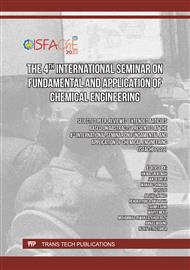p.89
p.97
p.105
p.113
p.121
p.129
p.137
p.145
p.153
The Effect of Using Clay-CaCO3 as Filler on Tensile Strength, %Elongation, and Young's Modulus Value in Modified Poly Lactic Acid (PLA)
Abstract:
Plastic is an important necessity with the characteristics of being light, strong, relatively cheap, and durable. However, plastic cannot decompose in a short time so that it becomes a pollutant. The using of Poly lactic acid (PLA) is an alternative to synthetic plastics substitute such as Low-Density Polyethylene (LDPE) because it is degradable. However, PLA is brittle, so it requires a plasticizer in the form of additives, namely Polyethylene glycol (PEG) 200 and fillers in the form of clay and CaCO3 to improve the mechanical properties of PLA which is brittle and has poor toughness. The purpose of this study was to determine the effect of adding additives to mechanical properties of PLA. The method used is solvent blending using chloroform as a solvent, stirring at 200 rpm for 6 hours at 30 . The research was conducted through testing the effect of the ratio of filler addition on the condition that the ratio of PLA/Additives was constant, i.e., 70%PLA/30% Additives. The resulting film is white and slightly transparent and has a smooth surface. The effect of adding additives in the form of plasticizers and fillers was tested through Dynamic Mechanical Analysis (DMA) analysis to determine the value of tensile strength, Young's modulus, and elongation break. The best result was obtained at a ratio of 25%CaCO3/Clay, which was increasing elongation at break 7.62%. It also indicated with best decreased percentage value of Young’s modulus, and highest crystallinity index of 39.86%. The worst value is obtained in variant of 50%CaCO3/Clay that indicated with lowest tensile strength and decreased of % elongation at break. From this study, the best variant was recommended as a laminating plastic, that does not require high tensile strength for application.
Info:
Periodical:
Pages:
129-135
Citation:
Online since:
February 2024
Keywords:
Price:
Сopyright:
© 2024 Trans Tech Publications Ltd. All Rights Reserved
Share:
Citation:



